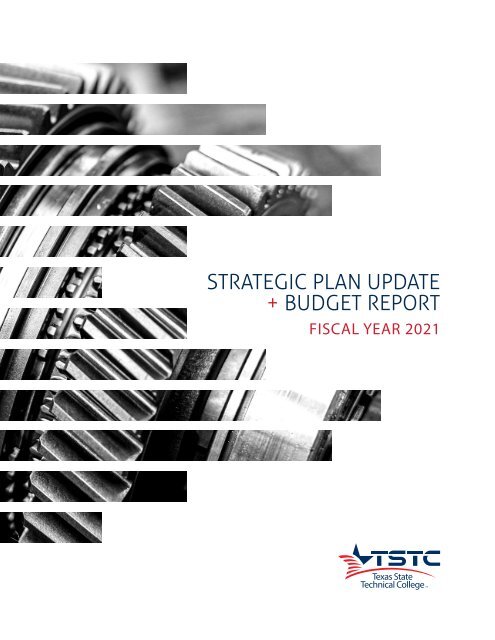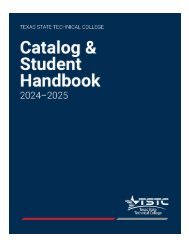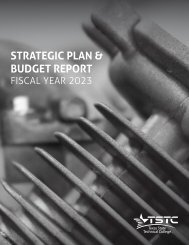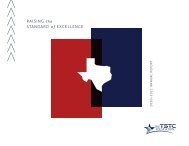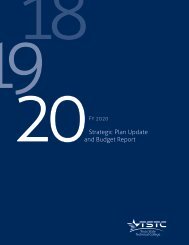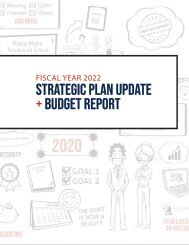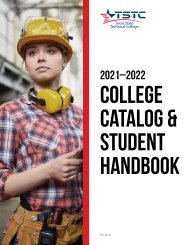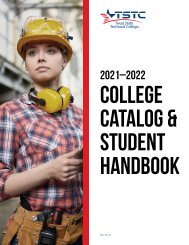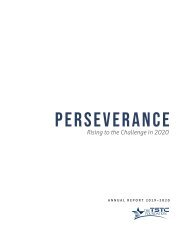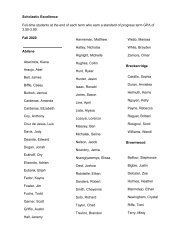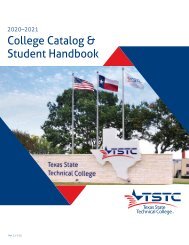Create successful ePaper yourself
Turn your PDF publications into a flip-book with our unique Google optimized e-Paper software.
STRATEGIC PLAN UPDATE<br />
+ BUDGET REPORT<br />
FISCAL YEAR <strong>2021</strong>
CORE VALUES<br />
EXCELLENCE<br />
ACCOUNTABILITY<br />
SERVICE<br />
INTEGRITY
APPROVED 08/20/2020<br />
TABLE OF<br />
CONTENTS<br />
4<br />
6<br />
11<br />
15<br />
16<br />
17<br />
21<br />
22<br />
23<br />
EXECUTIVE SUMMARY<br />
CONTEXT FOR PLANNING<br />
STRATEGIC PLAN UPDATE<br />
FISCAL YEAR <strong>2021</strong> BUDGET PRESENTATION<br />
FISCAL YEAR <strong>2021</strong> ANNUAL OPERATING BUDGET<br />
OPERATING REVENUES<br />
OPERATING EXPENDITURES<br />
CAPITAL BUDGET<br />
EXHIBITS<br />
STRATEGIC PLAN & BUDGET REPORT<br />
3
EXECUTIVE SUMMARY<br />
Introduction<br />
Each year during the August Board of Regents<br />
meeting, TSTC leadership presents its strategic<br />
plan. This presentation includes an assessment<br />
of the economy, the higher education industry,<br />
<strong>and</strong> the College’s performance to use as context<br />
for the submission of TSTC’s annual operating<br />
budget for approval. This process precedes the<br />
fiscal year, which begins on September 1 <strong>and</strong><br />
ends on August 31.<br />
Change Readiness, COVID-19 &<br />
the Economic Shutdown<br />
Several events in Fiscal Year 2020 interrupted<br />
daily life for most people across the globe. The<br />
spread of COVID-19 <strong>and</strong> the related economic<br />
shutdown crippled many industries, <strong>and</strong><br />
higher education did not get through the year<br />
unscathed. While no one could anticipate the<br />
reach <strong>and</strong> impact of these events, TSTC has<br />
prepared for threats to the traditional higher<br />
education paradigm for many years.<br />
Preparing for Lean Times &<br />
the “New Normal”<br />
TSTC’s leadership intervened early in the crisis<br />
with cost containment measures. Consequently,<br />
the College anticipates finishing Fiscal Year<br />
2020 with a budget surplus. Carrying forward<br />
these measures into Fiscal Year <strong>2021</strong> will enable<br />
leadership to propose a balanced budget. But<br />
reducing costs <strong>and</strong> maintaining the status quo is<br />
an incomplete response to the current situation.<br />
Leadership is assessing what the post-p<strong>and</strong>emic<br />
TSTC must look like to be relevant in a radically<br />
different future. The impact of those imperatives<br />
<strong>and</strong> long-term state funding issues require<br />
the TSTC community to ask, “What should we:<br />
Stop Doing? Start Doing? Keep Doing? Change<br />
Doing?” This assessment will be continuous <strong>and</strong><br />
will drive the College to constantly re-evaluate<br />
its allocation of resources to remain relevant in<br />
the “new normal”.<br />
TSTC’s Response<br />
The College’s teams rose to the challenges of<br />
shifting teaching modalities, preparing facilities,<br />
training faculty, <strong>and</strong> establishing necessary<br />
response procedures. This allowed TSTC to<br />
resume its core operations through the fiscal<br />
year, escaping the impact of the disruptions<br />
many others in the industry did not.<br />
<strong>Strategic</strong> <strong>Plan</strong> Momentum<br />
After reporting Fiscal Year 2019 performance<br />
that exceeded the final goals in TSTC’s inaugural<br />
strategic plan, the College recast new 3 <strong>and</strong> 5<br />
year stretch goals within the same focus areas<br />
of student success <strong>and</strong> organizational health.<br />
Performance within both goal areas is on track<br />
for Fiscal Year 2020, despite the seismic shifts<br />
in operations <strong>and</strong> the daily work life of the<br />
TSTC family.<br />
4<br />
STRATEGIC PLAN & BUDGET REPORT
APPROVED 08/20/2020<br />
<strong>Budget</strong> Highlights<br />
Notable budget items for Fiscal Year <strong>2021</strong><br />
include:<br />
Stable revenues anticipated within TSTC’s<br />
primary sources of funds (Appropriations<br />
<strong>and</strong> Tuition);<br />
Additional budgeted expenditures required<br />
to thrive in the new normal including<br />
additional faculty to maintain social<br />
distancing protocols;<br />
New costs to ramp up new offerings<br />
such as TSTC’s Rapid Industry Skills &<br />
Employability (RISE) series of short-term<br />
programs;<br />
Investment in program expansions in<br />
several high dem<strong>and</strong> program areas;<br />
Suspension of non-faculty hiring <strong>and</strong><br />
routine compensation adjustments; <strong>and</strong><br />
Continued investment in TSTC’s business<br />
process transformation project.<br />
Solar Energy Technology<br />
<strong>Budget</strong> Proposal & Approval<br />
Minute Order 30-20(c) recommends the Board<br />
of Regents approve an operating budget of<br />
$235,971,107 <strong>and</strong> the related allocations in<br />
support of the plans in this report. The summary<br />
of the budget request is found on page 16.<br />
Surgical Technology<br />
Welding Technology<br />
STRATEGIC PLAN & BUDGET REPORT<br />
5
CONTEXT FOR PLANNING<br />
A New Fiscal Year<br />
Fiscal Year 2020 began with an assessment of<br />
TSTC’s performance on its strategic plan. The<br />
results were promising. TSTC’s student success<br />
performance exceeded the set goals. Similarly,<br />
the College exceeded its expectations around<br />
employee engagement, the second goal of the<br />
strategic plan. With so much accomplished<br />
already, TSTC leadership got back to work with<br />
the Board of Regents to aspire for higher goals<br />
with a new horizon. In that spirit, the College<br />
renewed their plans for growing student success<br />
<strong>and</strong> organizational health.<br />
Maturing <strong>and</strong> refining TSTC’s programs <strong>and</strong><br />
operations to compete in a strong economy<br />
remained the College’s focus through the fall<br />
of 2019. The strong economy, evidenced by<br />
a historically low unemployment rate (3.5%<br />
in December 2019), presented recruiting<br />
challenges as TSTC competed for prospective<br />
students <strong>and</strong> faculty who were often lured to<br />
this strong labor market. A few months later, the<br />
environmental l<strong>and</strong>scape looked completely<br />
different.<br />
01<br />
Economic Lockdown<br />
As TSTC was planning for the return from winter<br />
break, the price of oil was just under $62<br />
per barrel. Simultaneously, the World Health<br />
Organization began reporting a cluster of<br />
pneumonia cases with no deaths in the Wuhan,<br />
Hubei province of China. In just a few months,<br />
the price of oil would drop to historic lows <strong>and</strong><br />
the outbreak of disease from Wuhan, China<br />
would become a global p<strong>and</strong>emic.<br />
The p<strong>and</strong>emic led to the lockdown of more than<br />
a third of the world’s population to stop the<br />
spread of what became known as COVID-19.<br />
This lockdown, or shutdown, slowed markets <strong>and</strong><br />
consumer activity, ushering in the most severe<br />
economic recession unlike any experienced<br />
in the last century. April 2020 employment<br />
figures in Texas showed a 13.5% unemployment<br />
rate <strong>and</strong> a decline of almost 1.3 million jobs<br />
in just over a month. This improved slightly in<br />
May <strong>and</strong> June to an 8.6% unemployment rate.<br />
While the June numbers offered a healthy sign<br />
of recovery, the depth of the Texas <strong>and</strong> national<br />
unemployment picture was, <strong>and</strong> will remain,<br />
staggering.<br />
6<br />
STRATEGIC PLAN & BUDGET REPORT
APPROVED 08/20/2020<br />
02<br />
At the same time, Saudi Arabia initiated a price<br />
war with Russia, signaling a push to oversupply<br />
the market with oil. Significant reductions in the<br />
dem<strong>and</strong> for oil, linked to the restrictions under<br />
the global p<strong>and</strong>emic, further impaired the oil<br />
industry. This would eventually drive the price<br />
of oil to historic lows, affecting not only the<br />
Texas oil <strong>and</strong> gas sector, but related industries<br />
<strong>and</strong> the state budget.<br />
This p<strong>and</strong>emic-driven recession <strong>and</strong> subsequent<br />
consumer lockdown came quickly <strong>and</strong><br />
relentlessly unlike the triggering events of other<br />
recessions.<br />
There are still many uncertainties regarding<br />
the pace <strong>and</strong> shape of the economic recovery.<br />
These uncertainties make it particularly difficult<br />
to not only forecast when employment will<br />
return to pre-p<strong>and</strong>emic levels, but also related<br />
issues such as student enrollments <strong>and</strong> revenue<br />
projections.<br />
Predictions from TSTC’s Workforce<br />
Economist, Rich Froeschle<br />
A widely held position by economists is that<br />
the recession is likely to be sharp, short <strong>and</strong> not<br />
sustained. TSTC is particularly concerned about<br />
the state of the recovery for both enrollment<br />
considerations <strong>and</strong> job placement opportunities<br />
for graduates, a key component of the funding<br />
formula.<br />
For longer term strategic planning purposes,<br />
it is valuable to think about the recovery from<br />
the COVID-19 recession in three waves; 1)<br />
the recovery from the ‘hurricane effect’ which<br />
is the rapid bounce in jobs caused by pentup<br />
dem<strong>and</strong>, <strong>and</strong> the ability to spend money<br />
once again at reopening businesses, 2) the<br />
downstream or delayed recovery as businesses<br />
adjust payrolls to the emerging spending<br />
environment. This likely slows the recovery as<br />
new rounds of layoffs accompany new waves<br />
of hiring, <strong>and</strong> 3) the labor reallocation phase<br />
as businesses take advantage of the recession<br />
to adjust how they use labor, what skills they<br />
need, <strong>and</strong> which new business models they will<br />
employ going forward.<br />
While there will definitely be new <strong>and</strong> emerging<br />
occupational skills resulting from the p<strong>and</strong>emic,<br />
in general, the industries <strong>and</strong> occupations that<br />
were most in dem<strong>and</strong> prior to the p<strong>and</strong>emic will<br />
continue to drive the economy in <strong>2021</strong>. These<br />
include the dem<strong>and</strong> for welding, energy, IT <strong>and</strong><br />
many health care skills.<br />
STRATEGIC PLAN & BUDGET REPORT<br />
7
Higher Ed’s Response &<br />
Future Implications<br />
The COVID-19 p<strong>and</strong>emic <strong>and</strong> the related<br />
shutdown triggered disruption that had<br />
devastating consequences for much of higher<br />
education. Congress passed the Coronavirus<br />
Aid, Relief, <strong>and</strong> Economic Security (CARES)<br />
Act in response to the economic fallout of<br />
the COVID-19 p<strong>and</strong>emic in the United States.<br />
This Act disbursed $14 billion in aid to public<br />
colleges <strong>and</strong> universities, of which more than<br />
$6 billion was restricted to direct assistance to<br />
students.<br />
Public colleges <strong>and</strong> universities across the<br />
nation spent enormous sums of money to<br />
support their students through the p<strong>and</strong>emic;<br />
switch to online education; <strong>and</strong> issue refunds<br />
to students for parking, housing, <strong>and</strong> dining<br />
services for the period of time when they were<br />
not on campus in the spring. For many public<br />
colleges, these costs alone were much higher<br />
than the federal funding they would receive<br />
from the CARES Act.<br />
Beyond basic financial needs, the p<strong>and</strong>emic<br />
forced most colleges to exp<strong>and</strong> their online<br />
curriculum, for better or worse. Some simply<br />
for survival. As many private colleges moved<br />
more of their curriculum online to address social<br />
distancing requirements, students <strong>and</strong> parents<br />
began questioning whether the loss of the<br />
traditional on-campus ‘college experience’ will<br />
still be worth the hefty tuition.<br />
In each of the three previous recessions there<br />
was a spike in total community <strong>and</strong> technical<br />
college enrollments at the beginning of the<br />
recession. Younger, unskilled workers are<br />
typically among the first to lose their jobs<br />
in a recession, thus the jump in the youth<br />
unemployment rate can be viewed as a leading<br />
indicator <strong>and</strong> accelerant for the return-to-school<br />
movement.<br />
8<br />
STRATEGIC PLAN & BUDGET REPORT
APPROVED 08/20/2020<br />
Fiscal Challenges at Legislature<br />
The economic contraction associated with the<br />
spread of COVID-19 <strong>and</strong> simultaneous volatility<br />
in oil markets poses significant challenges for<br />
state governments. Government entities will<br />
face budget shortfalls resulting from reduced tax<br />
revenues, including reductions in their primary<br />
revenue source, sales taxes, due to decreased<br />
consumption. In addition, costs to address the<br />
p<strong>and</strong>emic, including the purchase of personal<br />
protective equipment <strong>and</strong> other medical<br />
supplies, will take a financial toll. Consequently,<br />
budget balancing will require budget cutting<br />
in community services, public education, <strong>and</strong><br />
higher education.<br />
In late May, Texas state agencies were directed<br />
to reduce their annual budgets for the current<br />
biennium by 5%. Texas community colleges <strong>and</strong><br />
TSTC received exemptions from this directive<br />
likely due to the anticipated surge in enrollment<br />
that typically follows a recession. Consistent<br />
with this, TSTC is positioning itself to play a<br />
key role in the economic recovery by targeting<br />
the unskilled <strong>and</strong> underskilled <strong>and</strong> directing<br />
them towards the state’s highest industrial<br />
workforce needs.<br />
In late July, the Comptroller announced an<br />
update to his revenue estimate, which was<br />
down $11.5 billion from his October estimate.<br />
The forecasted deficit for Fiscal Year 2020<br />
was estimated at $4.5 billion compared to an<br />
estimated surplus of $2.9 billion.<br />
Looking beyond the current biennium, Texas<br />
agencies may likely face additional budget<br />
contractions. The belt-tightening for the state<br />
will likely dem<strong>and</strong> budget cuts from workforce,<br />
education <strong>and</strong> health <strong>and</strong> human services<br />
agencies, resulting in layoffs in these typically<br />
recession-resistant sectors.<br />
TSTC will plan for the probability of state<br />
budget reductions. Additionally, the College<br />
anticipates that several graduating classes will<br />
enter a distressed labor market, affecting their<br />
employment <strong>and</strong> earnings prospects. This could<br />
affect funding formula calculations <strong>and</strong> put a<br />
greater emphasis on offering programs with the<br />
greatest labor market opportunities.<br />
03<br />
Source of image: https://comptroller.texas.gov/transparency/reports/certification-revenue-estimate/2020-21-update/<br />
STRATEGIC PLAN & BUDGET REPORT<br />
9
TSTC’s Response to COVID<br />
For decades, TSTC has been evolving through<br />
constant change in pursuit of its mission.<br />
During the inaugural strategic planning event,<br />
TSTC’s leadership <strong>and</strong> the Board of Regents<br />
participated in a context setting retreat that<br />
focused on the following themes (among<br />
others):<br />
Disruptive Change is Incessant<br />
Exponential Change is the New Normal<br />
Stay the Same at Your Peril<br />
Innovation is Essential<br />
TSTC’s continual push to prepare for changing<br />
times positioned the TSTC family to respond<br />
with swift confidence to the events 2020 would<br />
introduce.<br />
TSTC leadership mobilized at the first signs that<br />
the global p<strong>and</strong>emic was spreading. Before<br />
COVID-19 arrived in North America, preparations<br />
for the exponential spread of this novel virus<br />
were underway at TSTC.<br />
As the new cases in Texas accelerated in<br />
mid March, TSTC extended the spring break<br />
<strong>and</strong> shifted its workforce to a remote work<br />
environment. Days later, Governor Abbott<br />
issued executive orders, including closure<br />
of in-person-attendance at Texas schools.<br />
TSTC was exempted because a majority of its<br />
programs are considered critical or essential.<br />
To remain open, TSTC’s Student Learning teams<br />
rapidly converted curriculum to online delivery<br />
of content (where applicable) <strong>and</strong> readied the<br />
College for a socially-distant <strong>and</strong> safe delivery<br />
of its lab-intensive coursework. This comprises<br />
nearly 60% of TSTC’s instructional delivery.<br />
To prepare the College for this format of<br />
teaching, teams worked to convert facilities,<br />
train faculty, transition non-teaching<br />
departments to remote-working, <strong>and</strong> prepare<br />
response procedures.<br />
On May 4, the College resumed on-campus<br />
instruction where it was required, enabling<br />
TSTC to complete the spring semester. Upon<br />
completion of the extended semester, the<br />
College started summer classes with the same<br />
protocols that ensured a safe extension to<br />
spring.<br />
In addition to overhauling the College’s<br />
learning delivery modalities, instructional<br />
teams developed several new products to<br />
provide solutions for Texas’ fast growing<br />
population of unemployed workforce. These<br />
new programs target essential skills to rapidly<br />
return unemployed <strong>and</strong> underemployed<br />
Texans back into the workforce.<br />
TSTC’s continual push to prepare for changing times<br />
positioned the TSTC family to respond with swift<br />
confidence to the events 2020 would introduce.<br />
10<br />
STRATEGIC PLAN & BUDGET REPORT
APPROVED 08/20/2020<br />
STRATEGIC PLAN UPDATE<br />
Historical Overview<br />
TSTC adopted its first statewide strategic plan in<br />
August 2017. The original plan contained three<br />
areas of focus, which became known as TSTC’s<br />
Wildly Important Goals or WIGs. The three goals<br />
focused on student success, financial stability,<br />
<strong>and</strong> organizational health.<br />
As a new college with a new plan, TSTC’s<br />
leadership selected Franklin Covey’s Four<br />
Disciplines of Execution, or 4DX, to facilitate a<br />
phased approach to executing its strategic plan<br />
goals.<br />
Phase 1 of the plan launched in spring 2018<br />
<strong>and</strong> focused on WIG 1, student success. As the<br />
College gained momentum, its focus on WIG<br />
1 success measures prompted a review <strong>and</strong><br />
refinement of the plan goals. In January 2019,<br />
about a year into the launch, a strategy meeting<br />
of the Board of Regents <strong>and</strong> College leadership<br />
convened <strong>and</strong> proposed modifications to the<br />
plan based on the lessons learned.<br />
As such, leadership proposed revisions to<br />
the strategic plan in the May 2019 <strong>Strategic</strong><br />
<strong>Plan</strong>ning Ad Hoc meeting of the Board. The<br />
resulting Board action impacted all three<br />
original WIGs, including the elimination of<br />
WIG 2 from the strategic plan.<br />
Finally, during Fiscal Year 2020, the College<br />
pivoted its focus on the strategic plan from<br />
WIG 1, student success to WIG 3, organizational<br />
health. While the focus on student success<br />
has become a sustained business practice<br />
in the division of Student Learning, the<br />
enterprise focused on increasing <strong>and</strong> sustaining<br />
organizational health through intentional<br />
interventions into the culture that sought to<br />
empower <strong>and</strong> engage the TSTC family.<br />
The New 3 & 5 Year WIGs<br />
Last year’s performance on the strategic plan<br />
was remarkable. During Fiscal Year 2019, TSTC<br />
exceeded the goals a year in advance of the plan<br />
for both WIG 1 <strong>and</strong> WIG 3. With this in mind,<br />
leadership deliberated with the Regents <strong>and</strong><br />
agreed upon new 3 <strong>and</strong> 5 year goals with the<br />
Board’s <strong>Strategic</strong> <strong>Plan</strong>ning Ad Hoc Committee.<br />
WIG 1 Student Success<br />
In considering new student success goals over a<br />
new horizon, the committee selected a scenario<br />
that anticipates 6 percent growth in annual<br />
enrollment <strong>and</strong> a 6 percent increase in graduate<br />
rate production. Using these assumptions to<br />
estimate the student success trajectory, the<br />
College is set to graduate 3,238 students in<br />
Fiscal Year 2022 <strong>and</strong> 3,549 students in Fiscal<br />
Year 2024.<br />
3-YEAR GOAL<br />
Return the graduate count from<br />
3,257 in Fiscal Year 2019 to 3,238<br />
by Fiscal Year 2022.<br />
5-YEAR GOAL<br />
Increase the graduate count from<br />
3,257 in Fiscal Year 2019 to 3,549<br />
by Fiscal Year 2024.<br />
WIG 3 Organizational Health<br />
According to TSTC’s survey provider, the<br />
University of Texas Institute of Organizational<br />
Excellence, scores above 400 are the result of<br />
a highly engaged workforce. Maintaining a high<br />
level of engagement requires constant focus<br />
<strong>and</strong> a sustained investment as expectations of<br />
the culture increase. To that end, TSTC has set<br />
an organizational health goal that increases <strong>and</strong><br />
holds the engagement score at or above 400.<br />
3-YEAR GOAL<br />
Increase the overall score on the Survey<br />
of Employee Engagement to 400 by<br />
Fiscal Year 2022.<br />
5-YEAR GOAL<br />
Increase <strong>and</strong> maintain the overall<br />
score on the Survey of Employee<br />
Engagement to 400 through<br />
Fiscal Year 2024.<br />
STRATEGIC PLAN & BUDGET REPORT<br />
11
Wildly Important Goal 1:<br />
Sustained Focus on Student Success<br />
04<br />
The focus on student success as a Wildly<br />
Important Goal has made planning <strong>and</strong><br />
evaluating instructional programs a habitual<br />
part of TSTC’s operations. As you can see<br />
in figure 04, WIG 1 continues to gain<br />
momentum in the sustainability phase.<br />
The goal is centered around increasing the<br />
number of graduates. TSTC continuously<br />
optimizes the pipelines that contribute to<br />
the flow of students who graduate <strong>and</strong> go<br />
into the workforce. Optimizing the pipeline<br />
includes curating TSTC’s mix of programs.<br />
Program closures in recent years account for<br />
the reduction in projected graduates after the<br />
peak in 2019. Over the last year, TSTC’s Core<br />
Operations have refined the Program Vitality<br />
Scorecard metrics to focus on pipeline inputs<br />
<strong>and</strong> outputs that drive program health <strong>and</strong><br />
vitality. Specifically, these metrics are:<br />
Enrollment<br />
Persistence<br />
Placement<br />
Salaries<br />
In addition to the new Vitality Scorecard,<br />
Student Learning is taking a decentralized,<br />
entrepreneurial approach to managing the<br />
portfolio of programs at TSTC. With 56 approved<br />
programs offered in various locations, the<br />
College has an inventory of just over 130<br />
unique program portfolios. These are known<br />
as the Individual Business Units, or IBUs.<br />
This structure supports the management of<br />
instructional strategies, program outreach,<br />
<strong>and</strong> student support initiatives from a localcommunity<br />
<strong>and</strong> regional-industry perspective.<br />
Each IBU is led by an Individual Business<br />
Manager, or IBM, <strong>and</strong> supported by the local<br />
Provost <strong>and</strong> the statewide program lead. This<br />
collaboration provides precision in terms of<br />
market alignment <strong>and</strong> performance while<br />
capitalizing on the expert <strong>and</strong> local knowledge<br />
of each IBM.<br />
As this structure matures, there will be<br />
innovation, best practices, <strong>and</strong> IBU successes<br />
that will further advance TSTC’s strategic plan<br />
<strong>and</strong> its mission of Placing More Texans in Great<br />
Paying Jobs.<br />
12<br />
STRATEGIC PLAN & BUDGET REPORT
APPROVED 08/20/2020<br />
Wildly Important Goal 3:<br />
A Focus on Organizational Health<br />
When TSTC realized the post-merger culture was<br />
suffering from change fatigue <strong>and</strong> uncertainty,<br />
the Board <strong>and</strong> leadership made a commitment<br />
to focus on Making TSTC a Great(er) Place to<br />
Work. The growth seen on figure 05 is indicative<br />
of the employee-centric efforts around WIG 3.<br />
The College has utilized the Survey of Employee<br />
Engagement, or the SEE, since 2016 to better<br />
underst<strong>and</strong> employee perceptions of their work.<br />
Survey results have revealed both strengths<br />
<strong>and</strong> opportunities throughout the College’s<br />
operations.<br />
With the desire to improve in all constructs<br />
on the survey, TSTC leadership selected a<br />
focus that would improve the professional<br />
experience <strong>and</strong> contributions of every TSTC<br />
teammate. Prioritizing the development of<br />
leaders <strong>and</strong> managers throughout the College<br />
has proved to be a worthy pursuit. TSTC Human<br />
Resources partnered with Franklin Covey to<br />
launch the 6-Critical Practices for Leading a<br />
Team, or 6CP, training in the summer of 2019.<br />
The 6CP framework <strong>and</strong> principles are tools for<br />
teaching proven behaviors <strong>and</strong> practices that<br />
build engaged teams, improve communication,<br />
<strong>and</strong> strengthen relationships. More than twothirds<br />
of TSTC’s managers have completed the<br />
6CP leadership training <strong>and</strong> are practicing the<br />
principles learned. This is one of many ways<br />
TSTC is working towards organizational health.<br />
Additional strategies that have an impact<br />
on WIG 3 include substantial investments<br />
in employee compensation, additional<br />
college-wide communication resources,<br />
<strong>and</strong> the opportunity to imagine a new way<br />
of doing business by implementing a new<br />
enterprise resource planning system. These<br />
efforts, augmented by the engagement <strong>and</strong><br />
empowerment realized by WIG 1, resulted in<br />
rising levels of employee engagement.<br />
05<br />
STRATEGIC PLAN & BUDGET REPORT<br />
13
Operational <strong>Plan</strong>ning & Assessment<br />
At TSTC, institutional effectiveness is integrated<br />
at all levels of the College, supported in<br />
particular through the operational rhythm of our<br />
administrative effectiveness cycle.<br />
All departments at TSTC engage in a<br />
comprehensive annual process of setting<br />
goals to measure operational efficiency <strong>and</strong><br />
quality of services. This process is guided <strong>and</strong><br />
affirmed by our TSTC value of accountability,<br />
<strong>and</strong> by our commitment to continuous quality<br />
improvement.<br />
This ongoing cycle allows the College to<br />
evaluate its performance in a meaningful<br />
way. It ensures that strategic initiatives<br />
<strong>and</strong> departmental goals are assessed to<br />
measure progress, operational effectiveness,<br />
performance improvement <strong>and</strong> quality service<br />
to our customers <strong>and</strong> teammates.<br />
Keeping this operational rhythm of assessment<br />
<strong>and</strong> evaluation requires discipline, especially<br />
during the COVID-19 p<strong>and</strong>emic. It requires TSTC<br />
to re-evaluate the upcoming fiscal year goals<br />
<strong>and</strong> consider whether they are still relevant <strong>and</strong><br />
achievable with an uncertain outlook; <strong>and</strong> if the<br />
resources <strong>and</strong> needs have changed in this “new<br />
normal” of conducting the business of higher<br />
education.<br />
06<br />
14<br />
STRATEGIC PLAN & BUDGET REPORT
APPROVED 08/20/2020<br />
FISCAL YEAR <strong>2021</strong><br />
BUDGET PRESENTATION<br />
Organizational Structure &<br />
<strong>Budget</strong> Framework<br />
TSTC’s organizational <strong>and</strong> leadership structures<br />
are optimized for growth <strong>and</strong> student success.<br />
The resulting allocation of resources across the<br />
organizational structure is illustrated below.<br />
Presentation, Assumptions & Estimates<br />
Various line items in prior year <strong>Budget</strong> <strong>and</strong><br />
Actual amounts were reclassified to align<br />
with the current organizational structure<br />
<strong>and</strong> budget framework for consistency in<br />
comparative analysis.<br />
Fiscal Year 2020 Forecast amounts <strong>and</strong><br />
certain Fiscal Year <strong>2021</strong> <strong>Budget</strong> amounts<br />
use available data <strong>and</strong> related estimates<br />
as of May 31, 2020.<br />
The College will realize appropriation<br />
revenues in accordance with bill patterns<br />
established by the 86th Legislature.<br />
TSTC prepares budgets using a cash basis<br />
of accounting.<br />
The annual budget report is a starting<br />
point. TSTC anticipates many refinements<br />
to this budget throughout the year as<br />
the needs <strong>and</strong> circumstances of all TSTC<br />
departments continually change.<br />
07<br />
5%<br />
Statewide<br />
5% Administration<br />
Finance<br />
10%<br />
Shared<br />
Resources<br />
32%<br />
Instruction<br />
13%<br />
Statewide<br />
Benefits<br />
<strong>2021</strong> <strong>Budget</strong><br />
$235,971,107<br />
16%<br />
Student<br />
Financial Aid<br />
19%<br />
Student<br />
Services<br />
STRATEGIC PLAN & BUDGET REPORT<br />
15
FISCAL YEAR <strong>2021</strong><br />
ANNUAL OPERATING BUDGET<br />
<strong>FY</strong> 2019 <strong>FY</strong> 2020<br />
<strong>FY</strong> <strong>2021</strong><br />
Operating Revenues<br />
Actual <strong>Budget</strong> Forecast <strong>Budget</strong><br />
Returned Value Formula Appropriations 46,978,296 66,124,351 66,124,351 66,124,351<br />
Special Items & Other Appropriations 18,771,643 23,000,122 23,000,122 23,169,199<br />
Debt Service Appropriations 3,744,007 3,758,882 3,758,882 3,757,232<br />
HEAF Appropriations 8,662,500 8,662,500 8,662,500 8,662,500<br />
Benefits Appropriations 25,747,740 24,021,822 25,124,858 24,885,151<br />
Tuition 43,656,253 47,281,046 43,733,977 44,192,647<br />
Student Financial Aid 34,497,457 33,190,901 32,570,285 33,369,711<br />
Auxiliary Enterprises 12,076,742 12,186,341 10,365,513 10,118,700<br />
Fees & Educational Sales 4,816,075 4,452,650 3,691,638 3,738,936<br />
Industry Relations 3,447,812 4,239,823 2,341,443 3,314,000<br />
Grants 5,887,318 5,042,497 8,224,632 9,006,112<br />
Contracts & Other 4,970,145 3,749,156 3,514,682 3,717,700<br />
Total Operating Revenues<br />
Carryforward / Vacant Positions<br />
213,255,988 235,710,091 231,112,883 234,056,239<br />
- 4,310,000 - 1,914,868<br />
Operating Expenditures<br />
Instruction 66,056,011 75,378,483 72,465,316 75,676,647<br />
Student Financial Aid 37,545,505 39,687,490 37,239,347 38,529,711<br />
Statewide Benefits 28,228,607 29,742,672 30,808,509 31,492,672<br />
Finance 8,965,349 10,746,089 9,932,823 10,756,887<br />
St Svcs Auxiliary Enterprises 11,283,039 10,954,519 10,202,462 10,966,612<br />
Enrollment Management 8,440,736 11,147,948 9,731,242 11,064,571<br />
Facilities 8,432,047 10,579,737 9,718,349 9,961,314<br />
Facilities - Transfer to Capital 2,128,907 3,690,836 3,690,836 1,832,924<br />
Information Technology 6,021,692 10,140,165 9,045,741 9,649,790<br />
Admin Advancement & Communications 5,523,239 7,085,881 6,430,232 6,322,093<br />
Statewide Administration 4,794,172 5,982,398 5,545,813 5,847,803<br />
Shared Debt Service & Leases 11,641,337 11,570,047 11,684,489 11,964,640<br />
Utilities & Other 6,810,438 7,785,303 7,540,870 7,784,277<br />
Grants 1,597,484 528,523 5,275,417 4,121,166<br />
<strong>Strategic</strong> Pool (to be allocated) - 5,000,000 - -<br />
Total Operating Expenditures<br />
Operating <strong>Budget</strong> Margin (Deficit)<br />
207,468,563 240,020,091 229,311,446 235,971,107<br />
5,787,425 0 1,801,437 0<br />
16<br />
STRATEGIC PLAN & BUDGET REPORT
APPROVED 08/20/2020<br />
OPERATING REVENUES<br />
Revenue Mix<br />
TSTC derives its budget from several sources<br />
of funds. State appropriations are the most<br />
significant revenue source, contributing 54<br />
percent of the College’s total revenues. Student<br />
tuition is the second largest category of<br />
revenues, contributing 19 percent of the total.<br />
Student Financial Assistance passes through the<br />
College <strong>and</strong> is eventually applied to students’<br />
accounts through an offsetting expense. Other<br />
supplemental revenues including grants, pilot<br />
training fees, housing rents <strong>and</strong> retail sales<br />
combine to account for 13 percent of total<br />
revenues.<br />
The illustration below demonstrates the relative<br />
contributions from the different sources of funds.<br />
CARES Act: Higher Education<br />
Emergency Relief Fund<br />
In response to the economic disruption caused<br />
by COVID-19, the federal government passed<br />
the CARES Act to provide funding for students<br />
<strong>and</strong> institutions of higher education. TSTC was<br />
awarded $10.6 million total; $5 million to be<br />
disbursed directly to students, <strong>and</strong> $5.6 million<br />
for the institution to use in meeting emergency<br />
needs <strong>and</strong> modifying the way instruction is<br />
delivered to students.<br />
In TSTC’s annual operating budget, these funds 14%<br />
Student<br />
are accounted for in the “Grants” line item,<br />
19%<br />
Financial<br />
in both revenue <strong>and</strong> expense. TSTC expects<br />
Tuition<br />
Assistance<br />
to expend much of the student portion in<br />
Fiscal Year 2020, as relief funds have been<br />
disbursed quickly to students. The majority 13%<br />
<strong>2021</strong> Revenues<br />
of the institutional portion is budgeted in Other*<br />
Fiscal Year <strong>2021</strong> as plans $234,056,239<br />
are currently in<br />
54%<br />
development Stateto identify the most critical <strong>and</strong><br />
strategic Appropriations needs caused by the disruption.<br />
08<br />
19%<br />
Tuition<br />
14%<br />
Student<br />
Financial<br />
Assistance<br />
Other*<br />
Grants<br />
Auxiliary Enterprises<br />
Fees & Educational Sales<br />
4%<br />
4%<br />
2%<br />
Contracts & Other<br />
2%<br />
Industry Relations 1%<br />
54%<br />
State<br />
Appropriations<br />
<strong>2021</strong> Revenues<br />
$234,056,239<br />
13%<br />
Other*<br />
STRATEGIC PLAN & BUDGET REPORT<br />
17
State Appropriations<br />
General Revenue appropriations for Fiscal Year<br />
<strong>2021</strong> remain constant in the second year of the<br />
state’s biennial appropriation at $126.6 million.<br />
In the 86th legislative session that concluded<br />
in May 2019, TSTC’s two-year appropriation<br />
increased 22 percent from the previous session.<br />
This substantial increase was primarily driven by<br />
the Legislature fully funding the amount TSTC<br />
earned in the Returned-Value Formula.<br />
In May 2020, many state agencies were directed<br />
by the Governor to cut 5 percent of biennial<br />
appropriations due to the economic disruption<br />
caused by COVID-19. TSTC was specifically<br />
exempted from this m<strong>and</strong>ate, which validates<br />
TSTC’s important role in the future economic<br />
recovery of Texas. Had TSTC’s appropriations<br />
been subject to the cut, appropriation revenue<br />
for Fiscal Year 2020 <strong>and</strong> <strong>2021</strong> would have been<br />
reduced by nearly $9 million.<br />
Other components of appropriation funding<br />
are considered “non-formula support”, which<br />
include the Small Institution Supplement,<br />
Institutional Enhancement, System Office<br />
Operations <strong>and</strong> Startup Funding strategies.<br />
Capital improvement funding from the HEAF<br />
appropriation <strong>and</strong> specific appropriations<br />
that pay for Tuition Revenue Bond retirement<br />
(debt service) also contribute to the total TSTC<br />
appropriations.<br />
09<br />
20%<br />
Benefits<br />
52%<br />
Returned-Value<br />
Formula<br />
<strong>2021</strong> Revenues:<br />
Appropriations<br />
$126,598,433<br />
18%<br />
Special Items<br />
& Other*<br />
7%<br />
HEAF<br />
3%<br />
Debt<br />
Service<br />
20%<br />
Benefits<br />
52%<br />
Returned-Value<br />
Formula<br />
<strong>2021</strong> Revenues:<br />
Appropriations<br />
$126,598,433<br />
18%<br />
Special Items<br />
& Other*<br />
7%<br />
HEAF<br />
3%<br />
Debt<br />
Service<br />
Special Items & Other*<br />
E&G Space Support<br />
5%<br />
Start Up Funding<br />
4%<br />
Small Institution Supplement 3%<br />
Institutional Enhancement<br />
3%<br />
System Office Operations & Other 2%<br />
Dual Credit 1%<br />
Special Items & Other*<br />
E&G Space Support<br />
Start Up Funding<br />
18<br />
STRATEGIC PLAN & BUDGET REPORT<br />
5%<br />
4%<br />
3%<br />
Small Institution Supplement<br />
Institutional Enhancement 3%
APPROVED 08/20/2020<br />
Tuition<br />
Tuition revenues are expected to remain stable<br />
for Fiscal Year <strong>2021</strong>, budgeted just 1 percent<br />
over where Fiscal Year 2020 is expected to<br />
finish.<br />
Fiscal Year 2020 tuition revenue is projected<br />
to be under the budgeted tuition of $47.28<br />
million. Revenues earned were short of budget<br />
because of enrollment expectations were<br />
not fully realized when gains from program<br />
expansions did not offset the losses from<br />
programs that were closing out.Even so, tuition<br />
for Fiscal Year 2020 stayed level with Fiscal Year<br />
2019 performance. In a year when the higher<br />
education industry suffered major losses from<br />
the shaken confidence of its student body,<br />
increasing tuition revenues over the prior year is<br />
an enviable position.<br />
Several factors influenced the tuition revenue<br />
expectations during Fiscal Year 2020 including<br />
the following:<br />
Increasing rates of returning students<br />
(persistence) resulted in stabilization of<br />
tuition revenue for Fiscal Year 2020.<br />
Lifts in tuition revenue overall from TSTC’s<br />
market-based pricing strategies that<br />
better align TSTC’s offerings to the varying<br />
dem<strong>and</strong>s of consumers <strong>and</strong> employers.<br />
Engagement <strong>and</strong> retention of its base<br />
of students during COVID-19 due to<br />
safety protocols implemented for faceto-face<br />
instruction <strong>and</strong> increased online<br />
instruction availability.<br />
10<br />
BUDGET<br />
PLAN<br />
MEASURE<br />
EXECUTE<br />
STRATEGIC PLAN & BUDGET REPORT<br />
19
Other Revenues<br />
In addition to the primary revenue sources of<br />
State Appropriations <strong>and</strong> Tuition, TSTC generates<br />
other revenues from a variety of services <strong>and</strong><br />
initiatives. Many of these services are referred<br />
to as Auxiliary Enterprises, which provide<br />
needed services for students, faculty, <strong>and</strong> staff<br />
<strong>and</strong> charge a fee related to that service.<br />
TSTC has seen material declines in these<br />
revenue producing activities with the onset<br />
of COVID-19, much like many institutions of<br />
higher education across the nation. Although<br />
TSTC is not nearly as reliant on these activities<br />
to produce significant revenue compared to<br />
traditional four-year universities, the decline<br />
still has an impact on TSTC’s overall budget.<br />
Housing <strong>and</strong> Retail Operations have been<br />
affected the most due to students moving<br />
home, reduced foot traffic on campus, <strong>and</strong><br />
new distancing requirements that reduce the<br />
capacity of available beds to lease. Additionally,<br />
the Waco campus abatement <strong>and</strong> demolition<br />
project will negatively affect housing revenue<br />
in the upcoming year. Many existing housing<br />
units will be vacated as abatement begins, <strong>and</strong><br />
Waco’s new 246 bed residence hall will not<br />
be ready for operation until Fiscal Year 2022,<br />
leaving a one-time gap in revenues during Fiscal<br />
Year <strong>2021</strong>.<br />
Training programs like Industry Relations<br />
<strong>and</strong> Flight Training have also experienced<br />
declines. Employers are engaging in less on-site<br />
workforce training <strong>and</strong> continuing education<br />
has seen a drop in dem<strong>and</strong> as well. Additionally,<br />
TSTC’s helicopter pilot training program was<br />
canceled in Fiscal Year 2020, which adds to the<br />
overall revenue decline.<br />
Managers of these business units have reduced<br />
expense budgets in Fiscal Year <strong>2021</strong> to<br />
correspond with the revenue declines, but the<br />
material loss of revenues has the potential to<br />
reach further into the College’s budget in the<br />
future. The outlook for these services to return<br />
to pre-COVID-19 levels is very uncertain, <strong>and</strong> a<br />
“new normal” will likely affect these functions,<br />
<strong>and</strong> the College overall, for years to come.<br />
11<br />
<strong>FY</strong> 2019 <strong>FY</strong> 2020<br />
<strong>FY</strong> <strong>2021</strong><br />
Actual <strong>Budget</strong> Forecast <strong>Budget</strong><br />
Other Revenues<br />
Retail Operations 5,950,525 5,795,841 4,318,319 5,386,500<br />
Housing 4,922,576 5,240,000 4,133,381 3,420,000<br />
Industry Relations 3,447,812 4,239,823 2,341,443 3,314,000<br />
Flight Training 2,735,682 2,400,000 1,550,000 2,050,000<br />
SkillsEngine 669,874 1,280,000 894,000 1,280,000<br />
Airport 976,800 970,000 1,735,877 1,112,000<br />
Total Other Revenues<br />
18,703,269 19,925,664 14,973,020 16,562,500<br />
20<br />
STRATEGIC PLAN & BUDGET REPORT
APPROVED 08/20/2020<br />
OPERATING EXPENDITURES<br />
12<br />
<strong>FY</strong> 2019 <strong>FY</strong> 2020 <strong>FY</strong> <strong>2021</strong><br />
<strong>Budget</strong> <strong>Budget</strong> <strong>Budget</strong><br />
Operating Expenditures<br />
Operating Costs 97,922,412 111,709,898 104,031,984<br />
Statewide Benefits 28,928,201 29,742,672 31,201,472<br />
Personnel Costs 87,240,822 93,567,521 100,737,651<br />
<strong>Strategic</strong> / Compensation Pool 7,226,904 5,000,000 -<br />
Total Operating Expenditures<br />
221,318,339 240,020,091 235,971,107<br />
Total operating expenditures budgeted for<br />
Fiscal Year <strong>2021</strong> are $236 million, compared<br />
to $240 million budgeted for Fiscal Year 2020.<br />
The decrease in expenditures is primarily<br />
attributable to belt tightening measures<br />
implemented by management in light of<br />
uncertainties related to COVID-19. During<br />
the annual budgeting process, departments<br />
considered multiple budget scenarios, <strong>and</strong><br />
made cuts in operating <strong>and</strong> travel costs after<br />
initial submissions proved untenable.<br />
A trend analysis shows TSTC’s significant<br />
investment in personnel costs over the last<br />
few years. In addition to using qualitative<br />
measures to evaluate TSTC’s progress on WIG<br />
3, the strategic plan intersects with the budget<br />
when it comes to improving compensation for<br />
TSTC teammates. This investment in personnel<br />
has certainly paid off from an engagement<br />
st<strong>and</strong>point but personnel cost increases are<br />
not one-time costs, <strong>and</strong> past increases must be<br />
annualized <strong>and</strong> factored into each new annual<br />
budget.<br />
Though much of the expense budget is held at<br />
a baseline level, management has not wavered<br />
on its commitment to improve TSTC’s enterprise<br />
resource planning software system by replacing<br />
it with Workday. A five year, $15 million software<br />
conversion project was approved to begin in<br />
Fiscal Year 2020, <strong>and</strong> the $3 million budget for<br />
the second year of the project is maintained<br />
in the Fiscal Year <strong>2021</strong> budget. The project<br />
involves completely transforming the day-to-day<br />
business operations of the College, including<br />
accounting, purchasing, budgeting, reporting,<br />
human resources operations, <strong>and</strong> ultimately<br />
student registration, scheduling <strong>and</strong> billing.<br />
Uncertainty is the primary driver of the Fiscal<br />
Year <strong>2021</strong> budget <strong>and</strong> the proposed expense<br />
budget has been trimmed where possible while<br />
currently maintaining full employment. Several<br />
new projects <strong>and</strong> initiatives have been put on<br />
hold, operating budgets have been reduced, <strong>and</strong><br />
no significant hiring or compensation increases<br />
are planned in the coming year.<br />
The tables that follow in the budget detail<br />
in Exhibit I provide greater detail about<br />
expenditures in the major organizational areas<br />
of the College.<br />
STRATEGIC PLAN & BUDGET REPORT<br />
21
CAPITAL BUDGET<br />
13<br />
FISCAL YEAR <strong>2021</strong> CAPITAL BUDGET<br />
Capital Funding Sources<br />
Series 2020<br />
RFS Bond<br />
Series 2016<br />
HEAF Bonds<br />
SB500 Demo<br />
Approriation<br />
Operating<br />
Transfers In<br />
Total<br />
Capital Project Uses<br />
Deferred Maintenance - - - 1,070,024 1,070,024<br />
Fort Bend Expansion 1,490,000 - - 600,000 2,090,000<br />
Waco ITC Renovation 15,149,750 - - - 15,149,750<br />
Waco Demolition Project - - 19,297,203 - 19,297,203<br />
Other Projects 1,934,210 589,000 - 162,900 2,686,110<br />
Total <strong>FY</strong> 21 Expenses<br />
18,573,960 589,000 19,297,203 1,832,924 40,293,087<br />
TSTC’s capital budget consists of inflows <strong>and</strong><br />
outflows of funds specifically identified for the<br />
acquisition, construction, <strong>and</strong> renovation of<br />
facilities <strong>and</strong> other long-term improvements.<br />
The most common source of funding for capital<br />
projects is debt <strong>and</strong> TSTC recently issued $30<br />
million of new debt (Series 2020 RFS bonds) to<br />
fund much needed expansion <strong>and</strong> renovation<br />
projects. The expenditure of the proceeds<br />
from this bond spans multiple fiscal years <strong>and</strong><br />
$18.6 million is planned to be spent in Fiscal<br />
Year <strong>2021</strong> on the projects outlined in the table<br />
above.<br />
In 2019, TSTC received a one-time,<br />
supplemental appropriation of $29.6 million<br />
from the Texas Legislature to fund a large<br />
scale abatement <strong>and</strong> demolition project at the<br />
Waco campus. The Waco campus was originally<br />
designed <strong>and</strong> constructed by the Federal<br />
government to serve as an Air Force base,<br />
<strong>and</strong> many of the original structures from the<br />
1950’s <strong>and</strong> 1960’s still remain. Abatement <strong>and</strong><br />
demolition of these structures will significantly<br />
enhance the “look <strong>and</strong> feel” of the Waco<br />
campus, <strong>and</strong> enable TSTC to reclaim ample<br />
l<strong>and</strong> for future growth <strong>and</strong> development. The<br />
appropriation is time limited, <strong>and</strong> all funds must<br />
be under contract by June 6, <strong>2021</strong>. Accordingly,<br />
a majority of the funds are budgeted to be<br />
expended in Fiscal Year <strong>2021</strong>.<br />
22<br />
STRATEGIC PLAN & BUDGET REPORT
APPROVED 08/20/2020<br />
EXHIBITS<br />
STRATEGIC PLAN & BUDGET REPORT<br />
23
EXHIBIT I: Detailed Operating Expense <strong>Budget</strong><br />
2019 2020 <strong>2021</strong><br />
Expense Type Original <strong>Budget</strong> Original <strong>Budget</strong> Original <strong>Budget</strong><br />
INSTRUCTION<br />
Academics Personnel Costs 9,840,426 9,991,875 9,149,308<br />
Operating Costs 1,002,183 926,177 755,084<br />
Total Academics 10,842,609 10,918,052 9,904,392<br />
Aerospace Personnel Costs 3,202,239 3,360,963 3,746,679<br />
Operating Costs 2,779,664 2,213,547 1,479,990<br />
Total Aerospace 5,981,903 5,574,510 5,226,669<br />
Allied Health Personnel Costs 3,886,880 4,275,915 4,129,305<br />
Operating Costs 496,422 522,993 617,534<br />
Total Allied Health 4,383,302 4,798,908 4,746,839<br />
C4EO Personnel Costs 1,380,093 1,396,641 1,530,140<br />
Operating Costs 418,464 418,464 343,774<br />
Total C4EO 1,798,557 1,815,105 1,873,914<br />
Construction & Safety Personnel Costs 1,259,191 1,394,117 1,433,741<br />
Operating Costs 224,265 215,149 212,166<br />
Total Construction & Safety 1,483,456 1,609,266 1,645,907<br />
Digital Transformation Personnel Costs 5,301,191 5,539,987 5,213,300<br />
Operating Costs 434,953 408,255 316,351<br />
Total Digital Transformation 5,736,144 5,948,242 5,529,651<br />
Electrical Instrumentation Personnel Costs 5,228,811 5,278,988 6,062,626<br />
Operating Costs 524,829 551,508 492,738<br />
Total Electrical Instrumentation 5,753,640 5,830,496 6,555,364<br />
Industrial Manufacturing Personnel Costs 5,788,740 5,684,414 7,334,024<br />
Operating Costs 1,471,365 1,744,896 1,267,210<br />
Total Industrial Manufacturing 7,260,105 7,429,310 8,601,234<br />
Industry Relations Personnel Costs 2,576,903 2,291,138 2,791,346<br />
Operating Costs 3,418,463 1,508,932 1,336,527<br />
Total Industry Relations 5,995,366 3,800,070 4,127,873<br />
Instructional Pools Personnel Costs 776,099 2,623,000 3,307,044<br />
Operating Costs 6,015,780 6,663,897 6,519,830<br />
Total Instructional Pools 6,791,879 9,286,897 9,826,874<br />
Instructional Sales Personnel Costs 3,436,404 3,509,157 3,767,276<br />
Operating Costs 949,317 914,574 716,026<br />
Total Instructional Sales 4,385,721 4,423,731 4,483,302<br />
Provosts & Admin Personnel Costs 3,232,792 3,569,548 5,216,464<br />
Operating Costs 588,701 588,423 702,076<br />
Total Provosts & Admin 3,821,493 4,157,971 5,918,540<br />
<strong>Strategic</strong> Partnerships Personnel Costs 399,712 459,232 125,744<br />
Operating Costs 50,000 1,686,846 56,200<br />
Total <strong>Strategic</strong> Partnerships 449,712 2,146,078 181,944<br />
Transportation Personnel Costs 3,454,641 3,516,725 3,772,873<br />
Operating Costs 470,923 491,858 414,933<br />
Total Transportation 3,925,564 4,008,583 4,187,806<br />
Vision & Alignment Personnel Costs 1,940,951 2,451,263 2,222,976<br />
Operating Costs 629,811 1,180,001 643,362<br />
Total Vision & Alignment 2,570,762 3,631,264 2,866,338<br />
TOTAL INSTRUCTION 71,180,213 75,378,483 75,676,647<br />
STUDENT FINANCIAL AID<br />
24<br />
STRATEGIC PLAN & BUDGET REPORT
APPROVED 08/20/2020<br />
EXHIBIT I: Detailed Operating Expense <strong>Budget</strong><br />
2019 2020 <strong>2021</strong><br />
Expense Type Original <strong>Budget</strong> Original <strong>Budget</strong> Original <strong>Budget</strong><br />
College Work Study Operating Costs 73,686 - 1,319,711<br />
Total College Work Study 73,686 - 1,319,711<br />
Equal Opportunity Grants Operating Costs 3,150,733 3,795,256 2,800,000<br />
Total Equal Opportunity Grants 3,150,733 3,795,256 2,800,000<br />
Institutional Scholarship Operating Costs 591,753 500,000 1,092,000<br />
Total Institutional Scholarship 591,753 500,000 1,092,000<br />
Loans Operating Costs 650,000 650,000 650,000<br />
Total Loans 650,000 650,000 650,000<br />
Pell Grants Operating Costs 28,650,000 28,650,000 28,000,000<br />
Total Pell Grants 28,650,000 28,650,000 28,000,000<br />
Tuition Set Asides Operating Costs 5,158,742 6,092,234 4,668,000<br />
Total Tuition Set Asides 5,158,742 6,092,234 4,668,000<br />
TOTAL STUDENT FINANCIAL AID 38,274,914 39,687,490 38,529,711<br />
TOTAL STATEWIDE BENEFITS Personnel Costs 28,928,201 29,742,672 31,492,672<br />
FINANCE<br />
<strong>Budget</strong> & Accounting Personnel Costs 2,194,916 2,311,793 2,289,092<br />
Operating Costs 268,749 232,414 245,356<br />
Total <strong>Budget</strong> & Accounting 2,463,665 2,544,207 2,534,448<br />
Business Intelligence Personnel Costs 776,572 1,075,772 1,091,732<br />
Operating Costs 75,025 245,347 175,812<br />
Total Business Intelligence 851,597 1,321,119 1,267,544<br />
Finance - Admin Personnel Costs 342,916 425,820 468,044<br />
Operating Costs 32,160 210,770 189,693<br />
Total Finance - Admin 375,076 636,590 657,737<br />
Human Resources Personnel Costs 2,021,012 2,281,755 2,535,800<br />
Operating Costs 436,442 674,660 561,700<br />
Total Human Resources 2,457,454 2,956,415 3,097,500<br />
Institutional Effectiveness Personnel Costs 583,276 628,719 743,795<br />
Operating Costs 291,962 283,340 180,805<br />
Total Institutional Effectiveness 875,238 912,059 924,600<br />
Procurement Personnel Costs 1,854,352 1,951,744 2,035,920<br />
Operating Costs 182,163 423,955 239,138<br />
Total Procurement 2,036,515 2,375,699 2,275,058<br />
TOTAL FINANCE 9,059,545 10,746,089 10,756,887<br />
AUXILIARY ENTERPRISES<br />
Airport & Farm Personnel Costs 415,500 337,559 322,411<br />
Operating Costs 378,342 428,342 428,342<br />
Total Airport & Farm 793,842 765,901 750,753<br />
Bookstore Personnel Costs 850,218 836,238 832,587<br />
Operating Costs 2,901,165 2,649,895 2,495,456<br />
Total Bookstore 3,751,383 3,486,133 3,328,043<br />
Food Service Personnel Costs 974,456 932,812 968,100<br />
Operating Costs 1,076,000 1,041,880 837,300<br />
Total Food Service 2,050,456 1,974,692 1,805,400<br />
STRATEGIC PLAN & BUDGET REPORT<br />
25
EXHIBIT I: Detailed Operating Expense <strong>Budget</strong><br />
2019 2020 <strong>2021</strong><br />
Expense Type Original <strong>Budget</strong> Original <strong>Budget</strong> Original <strong>Budget</strong><br />
Housing Personnel Costs 1,842,144 1,712,793 1,531,226<br />
Operating Costs 2,702,165 2,500,377 3,033,975<br />
Total Housing 4,544,309 4,213,170 4,565,201<br />
Printing Production Personnel Costs 284,664 281,928 302,424<br />
Operating Costs 225,962 232,695 214,791<br />
Total Printing Production 510,626 514,623 517,215<br />
TOTAL AUXILIARY ENTERPRISES 11,650,616 10,954,519 10,966,612<br />
ENROLLMENT MANAGEMENT<br />
Enrollment Management Personnel Costs 6,570,309 7,771,645 8,328,465<br />
Operating Costs 1,976,998 2,775,930 2,248,176<br />
Total Enrollment Management 8,547,307 10,547,575 10,576,641<br />
Student Services - Admin Personnel Costs - 416,274 308,840<br />
Operating Costs - 184,099 179,090<br />
Total Student Svcs - Admin - 600,373 487,930<br />
TOTAL ENROLLMENT MANAGEMENT 8,547,307 11,147,948 11,064,571<br />
FACILITIES - TRANSFER TO CAPITAL 2,066,890 3,690,836 1,832,924<br />
FACILITIES<br />
Fleet Personnel Costs 111,564 73,276 135,456<br />
Operating Costs 674,990 1,304,314 1,171,445<br />
Total Fleet 786,554 1,377,590 1,306,901<br />
Maintenance & Physical <strong>Plan</strong>t Personnel Costs 3,974,928 4,072,910 4,669,718<br />
Operating Costs 2,230,009 3,105,937 2,666,884<br />
Total Maint. & Phys. <strong>Plan</strong>t 6,204,937 7,178,847 7,336,602<br />
<strong>Plan</strong>ning Construction & Admin Personnel Costs 755,068 831,724 1,182,247<br />
Operating Costs 1,141,940 1,191,576 135,564<br />
Total <strong>Plan</strong>ning & Construction 1,897,008 2,023,300 1,317,811<br />
TOTAL FACILITIES 8,888,499 10,579,737 9,961,314<br />
INFORMATION TECHNOLOGY<br />
Infrastructure & Equipment Personnel Costs 547,572 511,276 529,440<br />
Operating Costs 306,041 893,561 480,881<br />
Total Infrastructure & Equip. 853,613 1,404,837 1,010,321<br />
Management Support & Operations Personnel Costs 3,207,832 3,178,390 3,263,702<br />
Operating Costs 486,373 493,860 214,916<br />
Total Mgmt. Support & Operations 3,694,205 3,672,250 3,478,618<br />
Shared Expenses Operating Costs 1,900,780 5,063,078 5,160,851<br />
Total Shared Expenses 1,900,780 5,063,078 5,160,851<br />
TOTAL INFORMATION TECHNOLOGY 6,448,598 10,140,165 9,649,790<br />
ADVANCEMENT & COMMUNICATIONS<br />
Advancement & TSTC Foundation Personnel Costs 2,258,805 2,454,333 2,692,935<br />
Operating Costs 485,907 715,477 489,958<br />
Total Advancement & TSTC Foundation 2,744,712 3,169,810 3,182,893<br />
Communication & Creative Services Personnel Costs 1,195,667 1,153,235 1,231,003
APPROVED 08/20/2020<br />
EXHIBIT I: Detailed Operating Expense <strong>Budget</strong><br />
2019 2020 <strong>2021</strong><br />
Expense Type Original <strong>Budget</strong> Original <strong>Budget</strong> Original <strong>Budget</strong><br />
Operating Costs 1,868,140 2,762,836 1,908,197<br />
Total Communication & Creative Svcs. 3,063,807 3,916,071 3,139,200<br />
TOTAL ADVANCEMENT & COMMUNICATIONS 5,808,519 7,085,881 6,322,093<br />
STATEWIDE ADMINISTRATION<br />
General Counsel Personnel Costs 1,929,346 2,391,586 2,412,404<br />
Operating Costs 499,665 703,854 622,417<br />
Total General Counsel 2,429,011 3,095,440 3,034,821<br />
Government Affairs Personnel Costs 540,176 856,781 773,125<br />
Operating Costs 197,437 208,429 187,586<br />
Total Government Affairs 737,613 1,065,210 960,711<br />
Internal Audit Personnel Costs 354,584 362,592 382,772<br />
Operating Costs 19,450 19,529 20,300<br />
Total Internal Audit 374,034 382,121 403,072<br />
Office of the CEO Personnel Costs 792,644 1,056,782 1,108,634<br />
Operating Costs 254,191 382,845 340,565<br />
Total Office of the CEO 1,046,835 1,439,627 1,449,199<br />
TOTAL STATEWIDE ADMINISTRATION 4,587,493 5,982,398 5,847,803<br />
SHARED RESOURCES<br />
Grants Personnel Costs 901,798 200,721 38,633<br />
Operating Costs 562,530 327,802 4,082,533<br />
Total Grants 1,464,328 528,523 4,121,166<br />
<strong>Strategic</strong> Pool Personnel Costs 2,922,597 5,000,000 -<br />
Operating Costs 4,304,307 - -<br />
Total <strong>Strategic</strong> Pool 7,226,904 5,000,000 -<br />
Utilites & Other Personnel Costs 127,571 102,624 121,492<br />
Operating Costs 6,071,106 7,682,679 7,662,785<br />
Total Utilities & Other 6,198,677 7,785,303 7,784,277<br />
Debt Services & Leases Operating Costs 10,987,635 11,570,047 11,964,640<br />
Total Debt Service & Leases 10,987,635 11,570,047 11,964,640<br />
TOTAL SHARED RESOURCES 25,877,544 24,883,873 23,870,083<br />
TOTAL OPERATING EXPENSES 221,318,339 240,020,091 235,971,107<br />
STRATEGIC PLAN & BUDGET REPORT<br />
27
EXHIBIT II: TSTC Definitions<br />
EXHIBIT III: TSTC Fund Accounting<br />
Summary<br />
Definitions<br />
<strong>Budget</strong> – An expenditure plan.<br />
28 STRATEGIC PLAN & BUDGET REPORT<br />
SACSCOC – Southern Association of Colleges<br />
<strong>and</strong> Schools Commission on Colleges, TSTC’s<br />
accrediting agency.<br />
Minute Order – Minute Orders are the<br />
documentation of action by the Board of Regents.<br />
Ad Hoc – A committee assigned by the Chairman<br />
of the Board of Regents to focus on a specific<br />
topic.<br />
4DX – Four Disciplines of Execution, a book by<br />
Chris McChesney, Sean Covey <strong>and</strong> Jim Huling that<br />
outlines an operating model for execution.<br />
CARES - Coronavirus Aid, Relief, <strong>and</strong> Economic<br />
Security Act<br />
WIG – Wildly Important Goal, a Franklin Covey<br />
term from the book 4 Disciplines of Execution.<br />
SEE – Survey of Employee Engagement, an annual<br />
survey that TSTC participates in to gather data on<br />
the teammates perception of the College.<br />
ERP – Enterprise Resource <strong>Plan</strong>ning software<br />
used to transform business processes, people <strong>and</strong><br />
technology.<br />
Pipeline – The progression of a student through<br />
TSTC from time of application to measuring wages<br />
in a placed job in the Texas workforce.<br />
Program Vitality – The analysis of enrollment,<br />
graduation, job placement, persistence, student<br />
wage reports <strong>and</strong> other metrics to inform program<br />
mix.<br />
Scorecard – A periodic report of key student<br />
success <strong>and</strong> performance indicators <strong>and</strong> outcomes<br />
designed to support the strategic direction of the<br />
College’s Student Learning division.<br />
IBU - Individual Business Unit is a specific program<br />
at a specific location.<br />
IBM - Individual Business Managers oversee<br />
specific IBUs<br />
Core Ops – A group of Vice Chancellors that<br />
have oversight of the College’s core operations:<br />
Student Learning, Student Service, Advancement &<br />
Communications, <strong>and</strong> Finance.<br />
TSTC budgets are essentially expenditure plans.<br />
TSTC expenditure plans must be balanced against<br />
revenues for each fund, including use of prior<br />
revenues within a fund balance.<br />
TSTC establishes budgets at the unit level. Once<br />
budgets are established, TSTC maintains fiscal<br />
control by monitoring expenditures against the<br />
budget.<br />
The Board adopts an original budget for each fiscal<br />
year. During the year, the budget is adjusted to<br />
account for any necessary changes, including new<br />
gifts, grants <strong>and</strong> other revenue sources as they<br />
occur. Only budget changes over $500,000 require<br />
Board approval.<br />
Contribution Margin – Revenue minus direct cost.<br />
Describes the unit’s ability to cover variable or<br />
direct costs with revenue.<br />
Fund – A sum of money saved or made available<br />
for a particular purpose.<br />
Fund Accounting – The accounting for funds that<br />
serve different or separate purposes. In effect,<br />
accounting for various funds can be compared to<br />
accounting for different companies or different<br />
divisions of a company. All transactions are<br />
separately accounted for to keep the fund<br />
balances separate even though actual cash from<br />
some of the funds may be co- mingled in local<br />
bank accounts.<br />
Fund Accounting Equation – Beginning Balance +<br />
Revenues – Expenditures = Ending Balance.<br />
Unit – An account code that is associated with a<br />
department or unique purpose. Any number of<br />
units make up a TSTC fund.
APPROVED 08/20/2020<br />
TSTC Funds<br />
Fund Numbers<br />
1. Education & General (E&G) – Appropriated by<br />
the state of Texas, kept in <strong>and</strong> expended from<br />
state treasury. Includes state tuition collected<br />
by TSTC (Fund 237) <strong>and</strong> general revenue of the<br />
state (Fund 001) for the purpose of instruction,<br />
student development, administration, operating<br />
<strong>and</strong> maintenance of plant, employee benefits<br />
<strong>and</strong> other authorized uses.<br />
2. Loan Funds – Gifts <strong>and</strong> tuition set-asides for<br />
student loans. Not budgeted. These funds are<br />
kept in TSTC local bank accounts.<br />
8. <strong>Plan</strong>t Funds – Funds set aside for construction,<br />
renovation, repairs <strong>and</strong> debt service. <strong>Plan</strong>t funds<br />
are unique in that they generally originate in<br />
the other funds <strong>and</strong> are then moved into plant<br />
funds through the budgeting process. Includes<br />
both funds held in the state treasury as well as<br />
funds in TSTC local bank accounts.<br />
9. Balance Sheet Accounts – This fund is a<br />
repository for all TSTC balance sheet accounts<br />
including assets, liabilities <strong>and</strong> net assets.<br />
3. Designated Funds – Funds for instruction,<br />
administration, operating <strong>and</strong> maintenance of<br />
plant, capital improvements, student services<br />
<strong>and</strong> other College uses. These funds are kept in<br />
TSTC local bank accounts.<br />
4. Auxiliary Funds – Includes funds related to TSTC<br />
operations that charge for services provided<br />
such as bookstores, food service, housing,<br />
airport <strong>and</strong> lease of property. These funds are<br />
kept in TSTC local bank accounts.<br />
5. Endowment Funds – Includes gifts or funds<br />
raised for providing long-term revenue<br />
for the College, from which only earnings<br />
are expendable. These funds are generally<br />
transferred to another fund prior to expenditure,<br />
not budgeted in Fund 5. These funds are kept in<br />
TSTC local bank accounts.<br />
6. Restricted Funds – Gifts <strong>and</strong> grants to be used<br />
for specific purposes defined by the external<br />
originating source: federal, state <strong>and</strong> local<br />
governments or private sources. These funds<br />
are kept in TSTC local bank accounts, but most<br />
operate on a reimbursement basis.<br />
7. Agency Funds – Funds which are other<br />
peoples’ money; administered by TSTC acting as<br />
custodian, such as for student organizations, The<br />
TSTC Foundation, etc. These funds are kept in<br />
TSTC local bank accounts. <strong>Budget</strong>s are set by the<br />
organization served.<br />
STRATEGIC PLAN & BUDGET REPORT<br />
29
EXHIBIT IV: Acknowledgements<br />
This presentation, accompanied by the video<br />
series, is the collaborative effort of many<br />
teammates across the College. Represented in the<br />
creation of these presentations are TSTC’s values<br />
of Excellence, Accountability, Service, <strong>and</strong> Integrity.<br />
The following teams <strong>and</strong> individuals contributed to<br />
this report <strong>and</strong>/or video representation of the past<br />
<strong>and</strong> future meaningful work done to Place More<br />
Texans in Great Paying Jobs while also making<br />
TSTC a Great(er) Place to Work.<br />
Thank you to these exceptional teammates:<br />
<strong>Budget</strong>, Accounting <strong>and</strong> <strong>Report</strong>ing Team<br />
Business Champions of the Enterprise Resource <strong>Plan</strong>ning Project<br />
Business Intelligence Team<br />
Communication <strong>and</strong> Creative Services Team<br />
Finance Administration Team<br />
Human Resources Team<br />
Institutional Effectiveness Team<br />
Printshop Team<br />
Key Contributors:<br />
Melinda Boykin, Executive Vice President for Procurement Services<br />
Robert Davis, Press Operator II<br />
Rich Froeschle, Senior Labor Market Economist<br />
Celina Garza, Vice President for Institutional Effectiveness<br />
Jonathan Hoekstra, Vice Chancellor <strong>and</strong> Chief Financial Officer<br />
Madelynne Johnston, Finance Chief of Staff<br />
Jonathan Lasley, Executive Vice President for Business Intelligence<br />
Jim Logan, Business Officer, Student Learning<br />
Pamela Mayfield, Associate Vice Chancellor for Human Resources<br />
Dawn Parker, Executive Assistant to the Vice Chancellor <strong>and</strong> Chief Financial Officer<br />
Ben Ranzinger, Rabenwolf Entertainment, LLC, Video Production<br />
Caitlin Simmonds, Publication Specialist II, Creative Services<br />
Chad Wooten, Associate Vice Chancellor for Finance<br />
Other Contributors:<br />
Nathan Ehlert, Senior Executive Director of <strong>Budget</strong><br />
Jay Gerik, Senior Executive Director for Business, Analytics, <strong>and</strong> <strong>Report</strong>ing<br />
Fern<strong>and</strong>o Guerrero, Senior Data Analyst<br />
Dave Huynh, Advanced Analytics Consultant<br />
David Kofnovec, Senior Financial Analyst<br />
Jessica Montalvo, Senior Financial Analyst<br />
Tina Skidmore, Senior Executive Director for Business, Analytics, <strong>and</strong> <strong>Report</strong>ing<br />
Stephanie Vestal, Senior Data Analyst<br />
Shannon Wiggins, Senior <strong>Budget</strong> Analyst<br />
30<br />
STRATEGIC PLAN & BUDGET REPORT
APPROVED 08/20/2020<br />
© Copyright Texas State Technical College, All rights reserved. Published August<br />
2020.<br />
Texas State Technical College (TSTC) is accredited by the Southern Association<br />
of Colleges <strong>and</strong> Schools Commission on Colleges (SACSCOC) to award Associate<br />
Degrees <strong>and</strong> Certificates of Completion. Contact the Southern Association of<br />
Colleges <strong>and</strong> Schools Commission on Colleges at 1866 Southern Lane, Decatur,<br />
Georgia 30033-4097 or call 404-679-4500 for questions about the accreditation<br />
of Texas State Technical College.<br />
Equal opportunity shall be afforded within TSTC to all employees <strong>and</strong> applicants<br />
for admission or employment regardless of race, color, gender, religion, national<br />
origin, age, genetic information, disability or veteran status. TSTC will make<br />
reasonable accommodations for persons with disabilities. TSTC’s policy is that, in<br />
all aspects of its operations, each person with a disability shall be considered for<br />
admission or access to or treatment or employment in its programs <strong>and</strong> activities<br />
in accordance with Part 84 of Title 45, the regulation implementing Section 504<br />
of the Rehabilitation Act of 1973.<br />
STRATEGIC PLAN & BUDGET REPORT<br />
31


